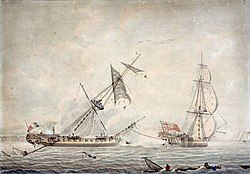
Naval engagements between warring nations were frequent throughout the 18th century, and often resulted in the capture of enemy vessels. Captured ships were often (but not always) renamed and incorporated into the victor's naval fleet. Merchant ships were also sometimes seized and repurposed for military service.
Contents
- 1701–1710
- 1702
- 1703
- 1704
- 1705
- 1706
- 1707
- 1708
- 1709
- 1710
- 1711–1720
- 1711
- 1712
- 1714
- 1715
- 1717
- 1718
- 1719
- Unknown date
- 1721–1730
- 1722
- 1725
- 1731–1740
- 1731
- 1739
- 1741–1750
- 1744
- 1745
- 1746
- 1747
- 1748
- 1751–1760
- 1755
- 1756
- 1757
- 1758
- 1759
- 1761–1770
- 1761
- 1762
- 1770
- 1771–1780
- 1775
- 1776
- 1777
- 1778
- 1779
- 1780
- 1781–1790
- 1781
- 1782
- 1783
- 1788
- 1789
- 1790
- 1791–1800
- 1793
- 1794
- 1795
- 1796
- 1797
- 1798
- 1799
- 1800
- Unknown date 2
- See also
- Notes
- References
- Bibliography
The following is a list of ships that were captured during the 18th century.





